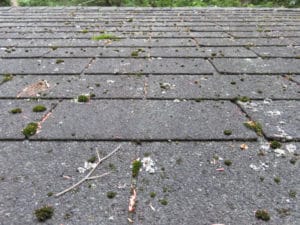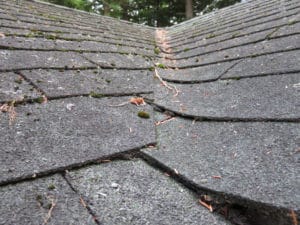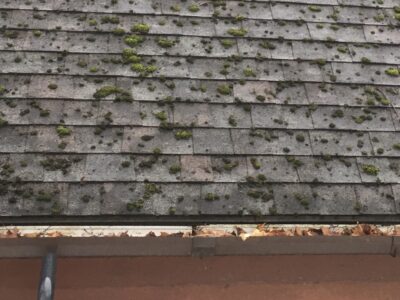Jean writes: I have a concrete tile roof and live in the Pacific Northwest where we have a lot of moss on our roofs. Over the years, the moss removal folk have broken many of my concrete tiles and we no longer can get replacements. The roof is 30 years old, and I am wondering if I should just remove it and get a composite or asphalt shingle roof. Would removing the extra support boards be very expensive? I really think this concrete tile roofing was a bad choice for my climate. I have no idea how the underlayment is doing at this point, but I wonder if it needs to be replaced anyway and this might be the best time to switch to a roof that would be easier to maintain in my moss-prone environment. Any comments on the cost and advise? Should I get new concrete tiles, or can I switch over to asphalt? Thanks.
Steve Bliss, of BuildingAdvisor.com, responds: The warm, cloudy, and rainy climate in the Northwest is ideal for growing algae and moss on roofs. In addition to the climate, the main factors affecting moss growth on roofs are:
- Shade vs. sunlight. Shaded roof areas and the north side of a roof will have the most growth as these stay wet longer.
- Roofing surface. Smooth, impervious surfaces trap less material to support growth and are easier to clean without damaging the surface. Choose smooth metal or glazed masonry over asphalt, wood, or porous tiles.
- Roof slope. Steep roofs with slippery surfaces tend to flush away material, keeping the roof surface clean.
- Water absorption. Materials that absorb moisture, like wood or unglazed clay or concrete will support growth better than waterproof finishes.
- Overhanging trees. In addition to shading the roof, leaf litter and debris from tress promotes growth. Consider trimming or removing overhanging trees.
- Algae-resistant materials. Roofing made from or treated with copper and zinc with naturally resist algae growth. This includes metal roofing and treated asphalt shingles.
- Attic ventilation. Poor attic ventilation can add moisture to roof area increasing the potential for wood decay and growth of mold and algae.
- Maintenance. Periodic cleaning is important. The buildup of moss and some types of algae will trap more water against the roof surface causing further growth and deterioration of the roofing material. Smooth, slippery surfaces, like metal or glazed tile, will be easiest to clean. Use a bristle brush and commercial roof cleaner, but avoid bleach and other harsh chemicals such as bleach and sodium hydroxide. A non-chlorine bleach such as StainSolver works well.
No roof is completely immune to moss and algae growth, given the right conditions, but some are better than others. In general, steep slope roofs with slippery surfaces are best because the water will flush off debris before it can build up and start the process. Copper and galvanized metal (anything with zinc) will fight the growth. For that reason, you might want to consider a metal roof. Standing-seam copper would be ideal, but there are many other metals and finishes that are more affordable. Any corrosion-resistant metal with a smooth durable coating would work. A smooth standing-seam or ribbed pattern would tend to trap less material than metal shingles. Check with local companies specializing in metal roofing. A high-quality metal roof should last 40-plus years.

Asphalt shingles are typically the least expensive option, but have undergone dramatic price increases in the past 10 years. So the cost difference between asphalt and premium materials is less than you might think. Algae-resistant asphalt shingles have material (usually copper granules), embedded in the surface that slowly dissolve and coat the roof to deter growth. For existing asphalt roofs, you can nail special copper or zinc strips over the ridge and hips to provide similar protection (copper is the most effective). If you are able to keep your roof relatively clean, you might get 20-plus years out of asphalt shingles in your climate. Moss and algae will definitely shorten their lifespan.
Composite roofing simulates slate, shakes, and clay tile. There are a wide variety of proprietary materials so it’s not easy to compare one to another or know exactly what you are purchasing. Some claim to be impervious water absorption, which would be a big plus in your area. They are much lighter than clay or concrete, a plus where structural support is an issue. If you are considering composites, look for a profile that does not trap a lot of material and is easy to clean. Also look for a product that has a proven track record in your region. In general, composites will not last as long as concrete or clay tile and may have the same problems as you currently do with moss growth.

As for switching over to another roofing type, you first need to determine how you current roof is installed. You may have purlins installed over continuous sheathing or the purlins may be attached directly to the rafters with no sheathing. You can probably determine what system you have by inspecting from the attic. In either case, you will need to remove the purlins to replace the underlayment. With the moisture buildup, the purlins are probably starting to decay anyway.
If you decide to stay with a concrete tile, you will still need to replace the purlins – and may want to add roof sheathing if missing. This will make a more walkable and durable roof that is easier to flash properly. Most other roofing types will need solid sheathing, the most common approach today.
I’d suggest talking to a few experienced roofers in the area for their suggestions. Also look at neighboring houses with similar roof pitch and conditions. See what is working best in your area. Once you decide on a roofing type, get at least three bids. You will often find significant differences in roofing bids for the same exact job.
Our sister site, Inspectapedia, has a good article on treating and preventing moss and algae on roofs.
Dee says
Maintaining Roofing With Moss from Tree Debris
My slight pitched roof is also Concrete Monier Tile, surrounded by trees (needles causing moss growth) though the trees don’t shade the roof. The roof is costly to maintenance requiring someone (not many) who knows how to step on the tiles without breaking them. We started looking into replacement, such as Composite Asphalt (GAF, CertainTeed), plastic (Brava, daVinci – expensive with own pros & cons).
Concern is gutter deterioration, corrosion caused by metal (copper, zinc) in the roof composition, metal used for roof installation (valleys and ridges), and human, animal, vegetation-friendly chemical moss for algae treatment (baking soda detergent oxidizes aluminum, copper, zinc, etc).
Suggestions for gutter type to replace existing aluminum gutters, considering composite asphalt or plastic roof replacement or if aluminum gutter is best, suggestion for roof maintenance to control growth and cleaning.
buildingadvisor says
Can’t recommend a specific gutter material until you have selected your roofing type — as you want these to be compatible. The most common gutter material is aluminum, which holds up pretty well under most conditions. Choose a heavy-gauge material for longest life. Add a good gutter screen system to help prevent organic debris from building up in the gutters and causing overflows and more maintenance work.
Where you have leaves, needles, and other tree debris collecting on a roof, you will have mold and moss growth, especially in a wet climate like yours (photo below).

Regular cleaning with low-pressure water would be my first suggestion. If a garden hose with a sprayer cannot do the job, try supplementing with a stiff scrub brush on the roof. Next step would be to hire a company to low-pressure wash with detergents and diluted bleach if needed.
Discuss the options, the chemicals used, and potential damage to plantings around the house.
High-pressure washing is the last resort as it can do a lot of damage to building materials if not done properly. Avoid this if you can.
Jean says
Thank you so very much for such a thoughtful and comprehensive response to my question. You have given us a lot to think about.
We are getting an independent roof inspector to take a look at our underlayment, and likely will be putting up a new asphalt roof, depending on hidden condition. Concrete tiles just don’t work very well here in our very wet part of the country – all of our neighbors have asphalt. We were fooled by the “lifetime” term used with concrete tiles – apparently the underlayment is NOT lifetime and we should have been inspecting it all along. If it needs to be replaced, then we will go with asphalt this time. Live and learn.
Again, thank you for your very valuable advice.